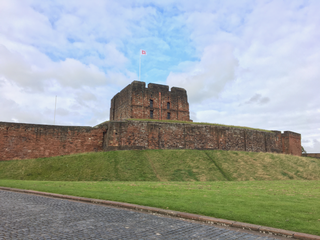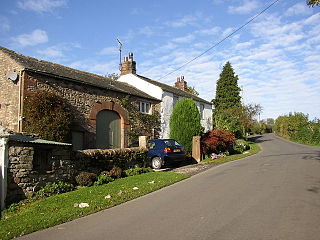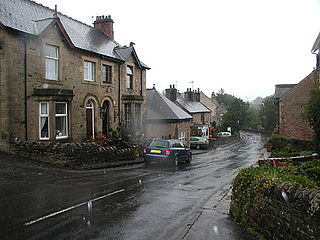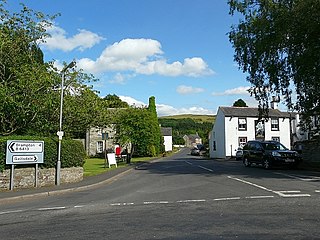
Baron Dacre is a title that has been created three times in the Peerage of England, every time by writ.

Carlisle Castle is a medieval stone keep castle located in the city of Carlisle near the ruins of Hadrian's Wall. First built during the reign of William II in 1092 and rebuilt in stone under Henry I in 1122, the castle is over 930 years old and has been the scene of many episodes in British history.

Dacre is a small village, civil parish and electoral ward in the Lake District National Park in the Eden District of Cumbria, England, and historically in Cumberland. In the 2001 census, the parish, which includes Newbiggin and Stainton, had a population of 1,326, increasing to 1,438 at the 2011 Census.
Baron Multon of Gilsland was a title in the Peerage of England. It was created when on 26 August 1307 Thomas de Multon was summoned to parliament. At his death, his daughter Margaret inherited the title; she married Ralph Dacre, who was summoned to parliament as Baron Dacre and not as Baron Multon in 1321. If the Multon barony was extant thereafter, it can be supposed to have descended with the new Dacre one.

Gilsland is a village in northern England about 20 miles (32 km) west of Hexham, and about 18 miles (29 km) east of Carlisle, which straddles the border between Cumbria and Northumberland. The village provides an amenity centre for visitors touring Hadrian's Wall and other features of historical interest in this area of rugged Border country, popularised by the Romantic novelist Sir Walter Scott.

Thomas Dacre, 2nd Baron Dacre of Gilsland, KG was the son of Humphrey Dacre, 1st Baron Dacre of Gilsland and Mabel Parr, great-aunt of queen consort Catherine Parr, the sixth and final wife of King Henry VIII of England. His mother was the daughter of Sir Thomas Parr of Kendal by his wife, Alice Tunstall.

Ralph Dacre, 1st Baron Dacre was an English peer.
Sir Thomas Dacre was born in Brampton, Cumberland, England.
Joan Dacre, 7th Baroness Dacre was a suo jure peeress of England. She was born in Gilsland, the daughter of Sir Thomas Dacre (1410–1448) and Elizabeth Bowett.

Laversdale is a village in Cumbria, England, situated to the north of Carlisle Lake District Airport. In 1870-72 the township had a population of 428. One of its more distinctive buildings is a thatched tithe barn, now a private house. The manor of Laversdale traditionally lies within the parish and bailiwick of Irthington in the Barony of Gilsland, and covers 3200 acres. It was held by the Earl of Carlisle until the 1980s.

Castle Carrock is a village and civil parish on the B6413 road, in the City of Carlisle District, in the English county of Cumbria about 3 miles (4.8 km) south of Brampton. The population of the Civil Parish was 303 in 2001 and rose to 328 by 2011. It has a pub, The Duke of Cumberland, a primary school and many walks. More recently Castle Carrock is known for 'Cumbria's Most Friendly Music Festival' Music on the Marr which takes place each year at the end of July. It attracts a diverse crop of music, entertainers, artists and poets from around the world.
Thomas Dacre, 4th Baron Dacre of Gilsland, 8th Baron Greystoke was an English Member of Parliament and after his father's death a peer and major landowner in the counties of Cumberland, Yorkshire and Northumberland.
George Dacre, 5th Baron Dacre of Gilsland, also Baron Greystoke was an English peer and landowner in the county of Cumberland.
Humphrey Dacre, 1st Baron Dacre of Gilsland, was an English soldier, Cumberland landowner and peer.

William Dacre, 2nd Baron Dacre was an English peer. In the final months of his life, he was also 3rd Baron Multon of Gilsland. In some sources, he is called William de Dacre.
William Musgrave MP, (1518–1597) of Hayton Castle was an English politician, Member of Parliament for the Cumberland Division.

Hugh Dacre, 4th Baron Dacre (1335–1383) was an English nobleman. He was born in 1335, the youngest son of Ralph Dacre, 1st Baron Dacre and his wife Margaret de Multon, 2nd Baroness Multon of Gilsland. His two older brothers preceded him in the barony, but both died childless. His brother William, the second baron, married but died childless in 1361. His brother Ralph, the third baron, was a clergyman who died unmarried and without issue in 1375. Hugh may have been implicated in his predecessor's death; he and Nicholas Harrington were excommunicated by the Archbishop of York, likely in connection with the murder, and they were both presented for the murder at Preston, though they escaped long-term repercussions.
de Vaux is the surname of an old Norman noble family.
Hubert de Vaux, also known as Hubert de Vallibus, was a prominent 12th-century English noble.
Burgh by Sands Castle was located near the village of Burgh by Sands, Cumbria, England.










